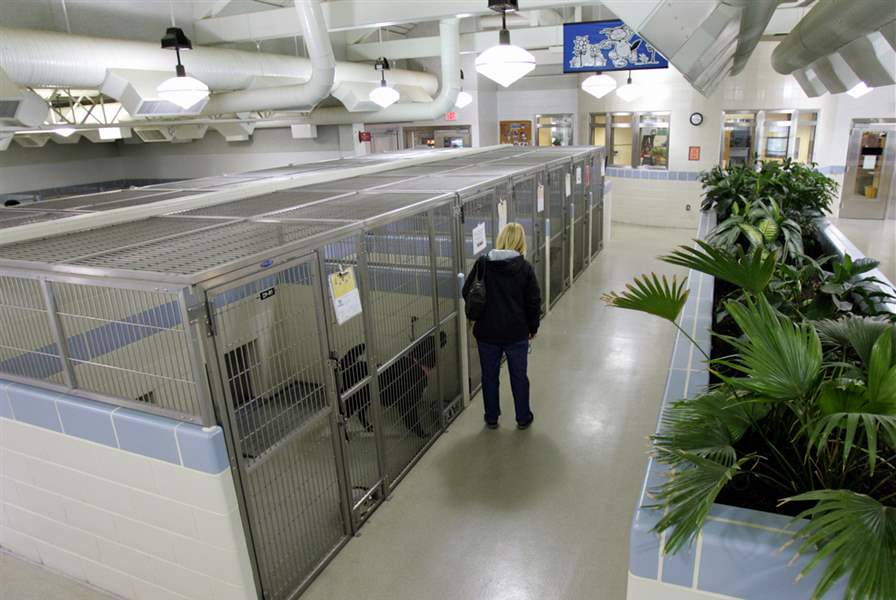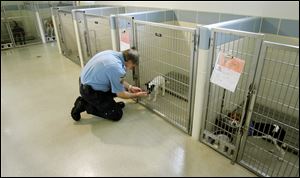
Dayton shows way in shelter reform; animal resource center becomes model
11/29/2009
A visitor checks out dogs ready for adoption at the Montgomery County shelter. Dogs are housed in six-foot-high kennels in a brightly lighted 24,000-squarefoot building.
Skip Peterson
DAYTON — The list of problems at the county dog pound kept growing.
Among the standouts: an old facility crowded with stacks of broken cages, inhumane treatment of the injured and sick, and euthanasia practices reported by the local newspaper as “harsh and sometimes seemingly arbitrary.”
Before long, county officials had a clamoring chorus of critics — pet owners, animal advocates, and veterinarians — all calling for them to do something. An oversight committee was formed. A national animal-rights group came in to evaluate. Residents demanded real changes.
Such was the case nearly six years ago at what was then the Montgomery County Animal Shelter in Dayton as local leaders set out to tackle animal control and public relations challenges similar to those now faced by Lucas County.
And with this month's announcement that controversial Dog Warden Tom Skeldon is retiring early after more than 22 years, animal-care advocates say Lucas County has a rare opportunity to re-examine the values, policies, and leadership it wishes to see at the warden's office.

A visitor checks out dogs ready for adoption at the Montgomery County shelter. Dogs are housed in six-foot-high kennels in a brightly lighted 24,000-squarefoot building.
Dan Grove, co-founder of the group 4 Lucas County Pets, views Mr. Skeldon as a holdover from the catch-and-kill era of animal control. With the departure, he said, “We have a chance to wipe the slate clean and start over.”
For Mr. Grove and other area pet advocates, northwest Ohio would do well to look downstate for inspiration from Montgomery County, which transformed its shelter from a community blemish to an operation admired across the state for balancing enforcement duties with service to dog and man.
Several Montgomery County shelter officials traveled to Toledo in September to give a presentation to members of Lucas County's Dog Warden Advisory Committee.
“Montgomery County is now like the gold standard,” said Tamara Ernst, also of 4 Lucas County Pets. “They have to follow the same Ohio Revised Code as we do, and yet they're a shining example of what can be done when you take a different attitude toward animals and a different attitude toward who you're serving — the public.”
Agents of change
Montgomery County's initial protesters found an open ear in county Administrator Deborah Feldman and then-Commissioner Vicki Pegg, who, with support from her two fellow commissioners, gathered the political will for a turnaround.
In spring, 2004, they ousted the shelter's two top managers and reassigned them elsewhere in the county. Although the managers were fulfilling their duties as set by the Ohio Revised Code, county leaders felt that animal control needed a new direction.

Robert Sexton checks a new arrival at the animal resource center, which, like Lucas County, does not adopt out ‘pit bulls.'
“It was a completely different approach, and it started with a county commissioner and myself realizing that we needed a different approach,” Ms. Feldman said. “There's a difference between what the basic state mandate is and what citizens believe and expect out of an animal organization.”
The solution involved placing greater emphasis on owner education, cooperation with rescue groups, and inviting citizen volunteers into the shelter to help walk, play with, groom, and care for the dogs.
Michael Sagester, shelter supervisor, said animals benefit when volunteers and the shelter employees, who are union members, work together. There are about 250 active volunteers.
“Our staff is doing the hard stuff — the cleaning, the feeding, the euthanasia — and we let them do the touchy-feely,” he said.
There was also a name change. There's no dog warden or animal shelter in Montgomery County, but an Animal Resource Center.
“We tried to modernize the profession … to get away from some of the old names that are still being used and are state law,” said Robert Sexton, animal control and care officer supervisor.
The facility
Perhaps most crucial to the transformation was a new $5.6 million facility. Opened in March, 2005, the animal resource center is off I-75 in a sunlit and airy 24,000-square-foot building with high ceilings and a distinctive orange roof.
Visitors enter a spacious lobby with a help desk and two glass-walled adoption areas for cats and kittens.
The center accepts stray and surrendered cats from area municipalities that pay a contractual fee. Dogs are kept in rooms behind the lobby in six-foot-high kennels with automatic water dishes and easy-to-clean floors.
Visitors are often surprised by the lack of smell in the kennel areas, a benefit of the building's ventilation system. Those looking to adopt can have one-on-one time with an animal in one of the “get acquainted” rooms.
Reaching out
Dog adoptions increased a reported 44 percent soon after the shelter opened. Current Director Mark Kumpf, a past president of the National Animal Control Association, arrived from Virginia about a year later, in July, 2006.
Mr. Kumpf is credited with helping lower the center's euthanasia rate by working with area rescue groups and humane societies so more of the adoptable dogs can find new homes. He also invites local rescues to use the center's conference room for “mingle with the mutts” adoption events.
The center uses its own van fleet to transport adoptable dogs to the Toledo Area Humane Society about every three weeks. Lucas County animal groups have for years criticized Mr. Skeldon for refusing to work with any “all-breed” dog rescues aside from Toledo's humane society, which says it imports dogs from other counties because it can't get enough locally from Mr. Skeldon.
Of the 6,099 dogs that entered Montgomery County's facility last year, 1,025 were returned to their owners, about 1,000 were adopted out, and nearly 400 were transferred to rescue groups, according to figures provided by the shelter.
The ‘pit bull' issue
All told, 65 percent of dogs not retrieved by owners last year were put down; the majority were “pit bulls.” Lucas County reported killing 77 percent of dogs not retrieved by their owners.
Mr. Sagester noted that for liability reasons, Montgomery County's policy forbids adopting out “pit bulls” to individuals or rescue groups. Ohio law deems “pit bull” breed dogs as inherently vicious regardless of behavior.
“Pit bull” is a generic term for a dog trained to fight and may refer to multiple breeds, including the American Staffordshire terrier, Staffordshire Bull terrier, American pit bull terrier, and, in Lucas County, other mixed breeds determined to be “pit bulls” by Mr. Skeldon.
“Not that we agree one way or the other, but if anything ever happened, we could be sued,” Mr. Sagester said.
Stark County in northeastern Ohio is one of the few in the state to adopt out “pit bulls.” Dog Warden Evert Gibson said officials there evaluate the animals and offer the friendly ones to responsible individuals or rescue groups.
Mr. Gibson said only six to eight “pit bulls” are adopted out a year. “When we tell people they're going to be spayed or neutered, then they don't want them because they want to take them home and breed them,” Mr. Gibson said.
Montgomery County, unlike Lucas County, gives an annual subsidy from its general fund for shelter operations.
The subsidy in 2010 will be $600,000 of the animal resource center's approximately $2.4 million total budget. Most of the center's annual revenue is from the sale of about 72,500 dog licenses, which increase next year to $20 from $16.
By comparison, Lucas County's $1.7 million dog warden budget is largely financed through 62,500 annual dog licenses that sell for $25, the highest fee in the state.
‘No-kill' quest
One of the few dog warden facilities in the country to reach a “no kill” status was Shelby County, Kentucky. Rusty Newton, acting animal control director, said his shelter, which takes in more than 900 dogs a year and receives government funding, was “no kill” between May, 2008, to May, 2009, when it did not have to euthanize any dogs aside from the severely sick or incorrigibly aggressive.
That achievement involved working with a network of nearly 300 rescue groups and shelters from Florida to New York, Mr. Newton said. The shelter lost its no-kill status when it became overrun with dogs last spring.
“When we did lose our status it was kind of a downer for everyone,” Mr. Newton said. “There were seven animals we had to put down — they were good animals, they were adoptable — but we serve a county and we have to provide that service and if they bring them in, we have to take them.”
A joint effort
Mr. Kumpf was traveling in England last week and unavailable for an interview. He said in an e-mail that he attributes Montgomery County's turnaround to a “commitment of not just our department, but the county administration, county commissioners, and our fellow animal welfare organizations.”
The director said law enforcement remains his department's primary role, but adoption, animal care, and owner education are also crucial for a successful shelter operation.
In a recent issue of Animal Sheltering magazine, published by the Humane Society of the United States, Mr. Kumpf described his own epiphany several years back.
“I thought that the way to correct animal problems was to cite everyone, impound everything, and be a good little animal cop,” Mr. Kumpf said. “But, I don't know, I just had one of those moments after I'd been on the job for a while and I thought, this really isn't doing anything. It was like bailing the ocean with a thimble.”
Calls for reform
Lucas County Commissioner Ben Konop, who has long pressed for reform at the dog warden department, said he hopes that Lucas County can adopt the reforms done successfully in Montgomery County. He has three chief priorities for the future dog warden: protecting the public, reducing animal suffering, and lowering the euthanasia rate.
But Mr. Konop's first recommendation would be christening the pound as Lucas County's new animal resource center.
“Changing the name will make the public aware that there's going to be a new outlook,” he said.
As Montgomery County did during its time of crisis, Lucas County's commissioners last year formed a citizens' advisory committee for suggestions on how dog warden operations could improve. So far, the recommendations have resulted in a formalized procedures manual at the pound and a moratorium on killing any puppies under 3 months of age, including “pit bull” puppies.
County commissioners have yet to say if the committee's work will change now that Mr. Skeldon is set to depart.
Count Mr. Grove of 4 Lucas County Pets among those who seek a top-to-bottom reassessment of the dog warden's mission and duties. “We need to have a new vision — it's not just a new person,” he said.
Contact JC Reindl at:jreindl@theblade.comor 419-724-6065.